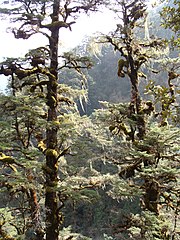Tsuga dumosa
| Habit | tree
| |
|---|---|---|
| Height: | ⇕ | 150 ft"ft" can not be assigned to a declared number type with value 150. |
| Width: | ⇔ | 25 ft"ft" can not be assigned to a declared number type with value 25. |
| Lifespan: | ⌛ | perennial |
| Exposure: | ☼ | sun |
|---|---|---|
| USDA Zones: | 8 to 10 |
|
Pinaceae > |
Tsuga > |
dumosa > |
Tsuga dumosa, commonly called the Himalayan Hemlock is a species of conifer native to the eastern Himalayas. It occurs in parts of India, Burma, Vietnam, Tibet, and China. Within its native range the tree is used for construction as well as for furniture. In Europe and North America, it is occasionally encountered as an ornamental species and was first brought to the United Kingdom in 1838.
T. dumosa is a tree growing 20 to 25 metres (65 to 80 ft) high and exceptionally to 40 m (130 ft). The diameter at breast height is typically 40 to 50 cm (16 to 20 in), but can be beyond 100 cm (40 in).[1] The crown on small trees is ovoid and their form is like that of pendulous bushes. Older trees tend to have multiple stems from one or two sinuous boles, especially in cultivation. The crown of mature trees is broad, irregular-pyramidal and open. The bark is a similar to that of an old larch: somewhat pinkish to grey-brown and heavily ridged with broad, shallow, flaky fissures.[2] The branches are oblique or horizontal. The twigs are reddish brown or greyish yellow in their first year and are pubescent, i.e. covered with short hairs. Branches that are 2 to 3 years old are greyish brown or dark grey with leaf scars. The wood from the tree is a brownish yellow with a fine structure and straight veins.[1]
The leaves are spirally arranged, pointing forward on the branches and placed distantly from one another compared to other species in the genus Tsuga. They are linear in shape, and 10 to 25 mm (0.5 to 1 in) long by 2 to 2.5 mm (0.07 to 0.1 in) wide. The ends are obtuse or rounded, and very occasionally emarginate. The upper surface of the leaves is green and shiny, while the undersides have 2 wide silvery stomatal bands. The upper half of the leaves usually have small dents on the margins, i.e. the margins are rarely entire. The midrib is concave on the upper surface. [1][2]
The stamenate flowers are globose in shape, solitarily arranged and axillary. The anthers are a green-yellow in colour and they lack an air sac. The pistillate flowers are round-ovate in shape, also solitarily arranged, terminal and slightly down-curved. They have many spiral scales with 2 ovules contained within each scale. The seeds are about 9 mm (0.4 in) long, ovate in shape, brown in colour and have thin wings in their upper parts. Flowering occurs from April to May and fruiting from October to November.[1]
Cultivation
Propagation
Pests and diseases
Varieties
Gallery
References
External links
- w:Tsuga dumosa. Some of the material on this page may be from Wikipedia, under the Creative Commons license.
- Tsuga dumosa QR Code (Size 50, 100, 200, 500)

